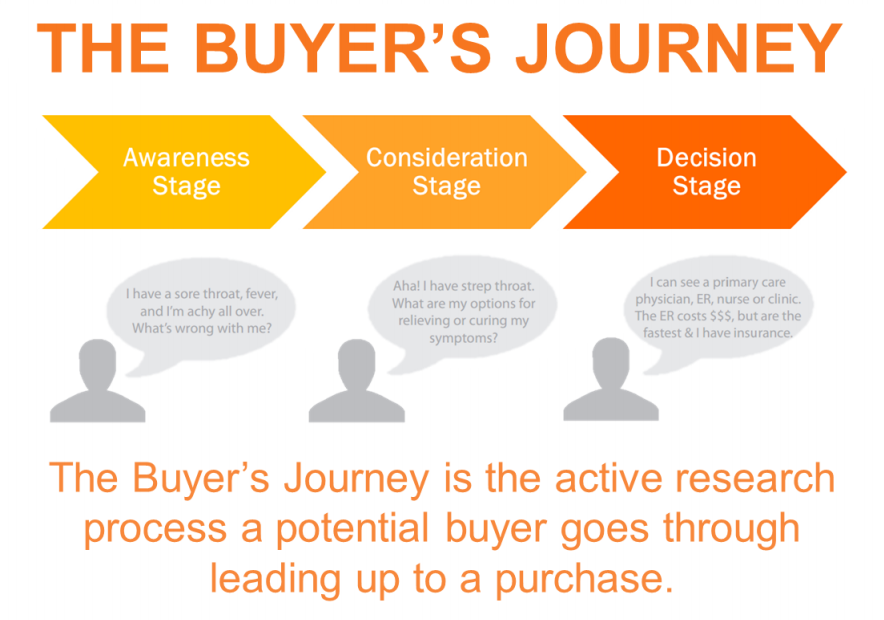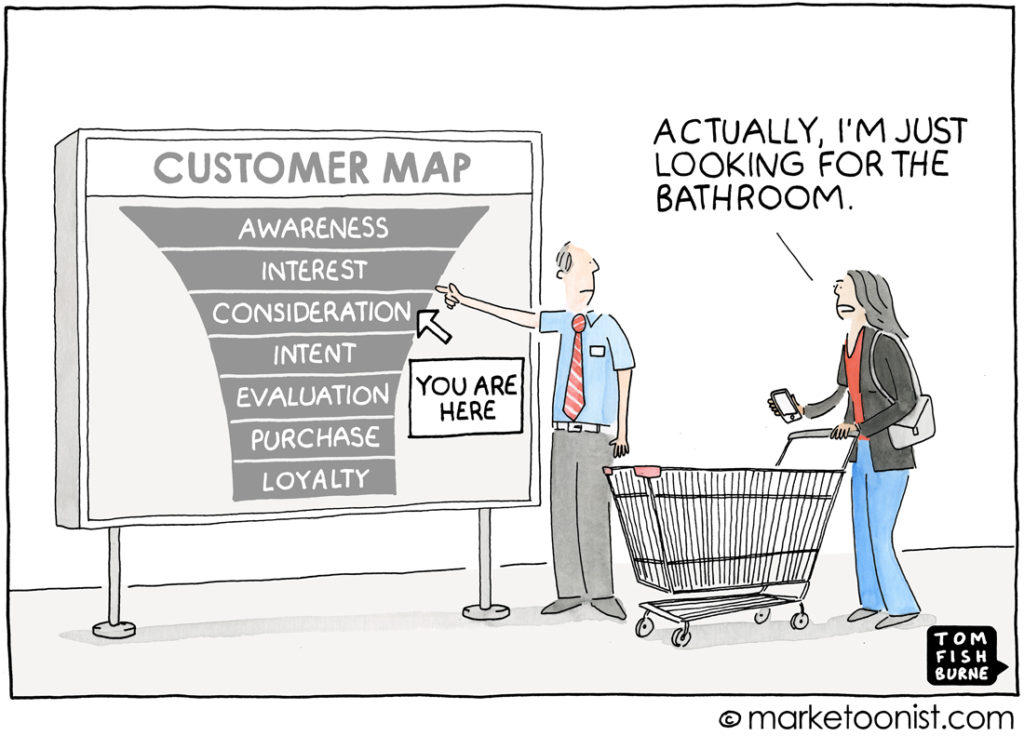The Marketing Funnel is dead, but these 6 common mistakes that lead to its downfall still haunt digital marketers today.
People have been using marketing funnel models for longer than we’ve been using flashlights, paper clips, or vacuum cleaners. In all that time, paper clips might be the only one that’s seen less innovation than the marketing funnel. Perhaps that explains the “unfinished business” keeping it’s ghosts still lurking in so many conference rooms today…
I am not the first to pronounce the marketing funnel dead. Dozens of people have posted obituaries on the late marketing and sales funnel. August 2011 was the earliest article I found on Google before giving up.
So why beat a dead horse?
Because the marketing funnel might be dead, but it’s ghosts continue to haunt us. In talking to a lot of Marketers about the customer journey, I frequently run into many of the same plagues that “killed” the marketing sales funnel still coming up in conversation and reeking havoc. So, I think it’s worth while to dust off the autopsy report and examine some of the important flaws that lead the funnel to extinction.
I will also admit that I sometimes fantasize about sticking buyer’s journey models right in the coffin along with the funnel (what a completely normal, not at all weird thing to say.) Seriously though, not only do I dislike the word “buyer’s” to begin with due to it’s inherent lack of focus beyond the point of purchase and its narrow focus on the buyer, but many “buyer’s journey” models also commonly share some of the very same fundamental flaws as the marketing funnel.
6 Reasons Why Traditional Marketing Funnels and Buyers’ Journey Models Fail
1. The idea that customer journeys are linear (they’re not).
This is one of the most common misconceptions I see. In a traditional marketing funnel, customers typically enter at a top stage called something like “awareness” and move through each stage sequentially until the reach purchase-the stages may differ, but this linear view of the journey is pretty constant. However, this is the wrong way to think about it – customer journeys are not linear. Customers not only enter at all different stages but they often skip over stages entirely, move back and forth between stages, or will stay at one stage indefinitely. Don’t sit down and map out a step-by-step process that says “first they’ll do this, then they’ll do that, next they’ll do this…” and expect that your customers will actually follow your plan. Customers are in total control of their own journeys and will do what they want, when they want, in the order they want. Some reports are saying that up to 90% of the customer journey is now self-directed. Marketers have the power to influence a customer’s journey, but not to dictate or control it. Instead, it’s more about making sure customers can find you at any stage, get what they are looking for, and find more to help bridge them on towards the next stages in their journey.
2. Not acknowledging the fact that customers can enter the journey at any stage.
Customers don’t all begin their journeys at any one specific stage. There is no designated “first” “top” or “early” stage which serves as the single gateway through which customers enter our universe. As an example, a lot of the time our prospective customers are being nurtured by our competitors, and then show up at our doorstep at a later stage. One customer might find you by searching “alternatives to Competitor XYZ” while actively looking to implement a solution, while others (as we’ll see in a later section) might find you before they even know they have a problem yet. These are just a few examples of many possible ways in which customers can begin their journeys at different stages (I will do a deeper dive on this topic in a later post.)
3. Lacking focus beyond the point-of-purchase.
While it can cost as much as 5-10X more to generate a new customer than it does to retain an existing one, most models are predominantly – if not entirely – focused on pre-purchase stages, as opposed to relationships with existing paying customers. The term “buyer’s journey” in itself is representative of an intrinsic mindset that focuses on the purchase, and not what happens after (why this blog is named Customer Journey Marketer.) Regardless even of acquisition/retention costs, the fact remains that – next to its employees – existing customers are the single most important asset to a company’s success. Trying to grow a business without a happy, loyal, customer-base is trying to climb a ladder without a foundation. And the majority of the time, customers don’t magically go from closed won deals to brand advocates. Just like for pre-purchase, there are a series of stages customers go through and needs that we must address to help ensure a successful progression to advocacy. And yet, for most models we use, post-purchase is barely existent, if it all.
4. Lacking granularity.
As a digital marketer in the tech space, the importance of simplicity is by no means lost on me. However, in the case of defining customer journey stages, over-simplification can be a weakness. If you are not granular enough here, it gets harder to keep a clear view of the specific questions, needs, and barriers your customers encounter at each different stage of their journey, that you will need to understand and address in your marketing.
By simply thinking in terms of things like “TOFU, MOFU, BOFU,” you are:
a) Looking at the customer journey from a marketer’s POV as opposed to that of the customer.
b) Making the assumption that every customer randomly assigned to one of these buckets requires the same treatment.
With a more granular approach, it is much easier to make sure we covering all the bases and encompassing all scenarios, while maintaining a tighter handle on the specific objectives we need to accomplish to help our customers successfully navigate their journeys – the smaller battles that add up to winning the war.
5. Lacking a complete view of the entire journey.
As we’ve already discussed with the neglect of post-purchase parts of the life-cycle, many models out there often have a narrowed scope that fails to encompass the customer journey in its entirety, which spans from the very first time a customer encounters a company/brand, all the way through to customer advocacy, and every step in-between. I will pick one of Hubspot’s buyer’s journey models below because it happens to be guilty of most of the flaws outlined in this post.

With this model above we have a good example of an incomplete view of the journey. Whereas here we are seeing the journey begin in the awareness stage with the customer having a problem and pain points, in reality, many times customer journeys can begin before a customer even knows they have a problem. Ironically, this is probably even especially true for Hubspot more often than the average company due to their incredible reach and brand strength they’ve achieved largely through their content marketing. How many Hubspot customers do you think engaged with the brand at some point prior coming to them with a problem? Many if not most would be my guess. How many Hubspot customers might not have come to them with a problem in the first place if not for having already developed an awareness and positive perception of the brand?
Those of us of who didn’t pioneer inbound marketing and aren’t quite averaging 15+ million web visits a quarter (33% organic, 31% via blog) like Hubspot just yet, we need to make sure we have a clear view of how wide we are casting our net to attract our target audiences and build brand awareness even before they have the problem, otherwise they won’t know to come to us when they do. Even better, perhaps we will tell them. And even in Hubspot’s case, if it were me I would want a more granular understanding of the instruments driving all that traffic to see why more of those 60+ million web visitors a year are not converting (subtract from that 29% direct because it’s a SAAS business, same difference).
If your significant other had met you and had a crush on you years before you were able to start dating, would you not count that as a part of the story of how your relationship came to be?
And it’s not just at the “top.” As far as the customer journey spans, so must our models, in order to truly have end-to-end clarity of the lifecycle of the relationship.
6. Not accounting for external influences.
Also absent from these models are often influential forces that can have a significant impact on the customer journey and purchasing decision, such as colleagues and peers, other advocates, and social media. You could say that over recent years, social media has started to become the “go-to” place for brands to market their business, as well as their products and services, with the hope that their customer numbers and sales increase. Once you have looked into organic growth on Instagram and how an increase of followers can benefit you, the road to providing customers with what they’re looking for is well underway.
(Ciceron)
The connected nature of the digital world makes it easier than ever for customers to consult peers, colleagues and often total strangers for input on a purchasing decision. This is another example that can cause a customer to skip from an early stage right to a more purchase ready stage, again underscoring the misconception of the customer journey being linear.
Stay Tuned for My Next Post: The Birth of a New Model
Now that we’ve covered some of the major flaws of traditional marketing funnels and buyer’s journey models, in my next post, Understanding the Stages of the New Digital Marketing Funnel, I will walk you through a new model designed to address some of the shortfalls we covered today, and do a deep dive through each stage from a customer’s perspective, and also a Marketer’s.
What customer journey models are you using? What advantages and disadvantages do you see?

